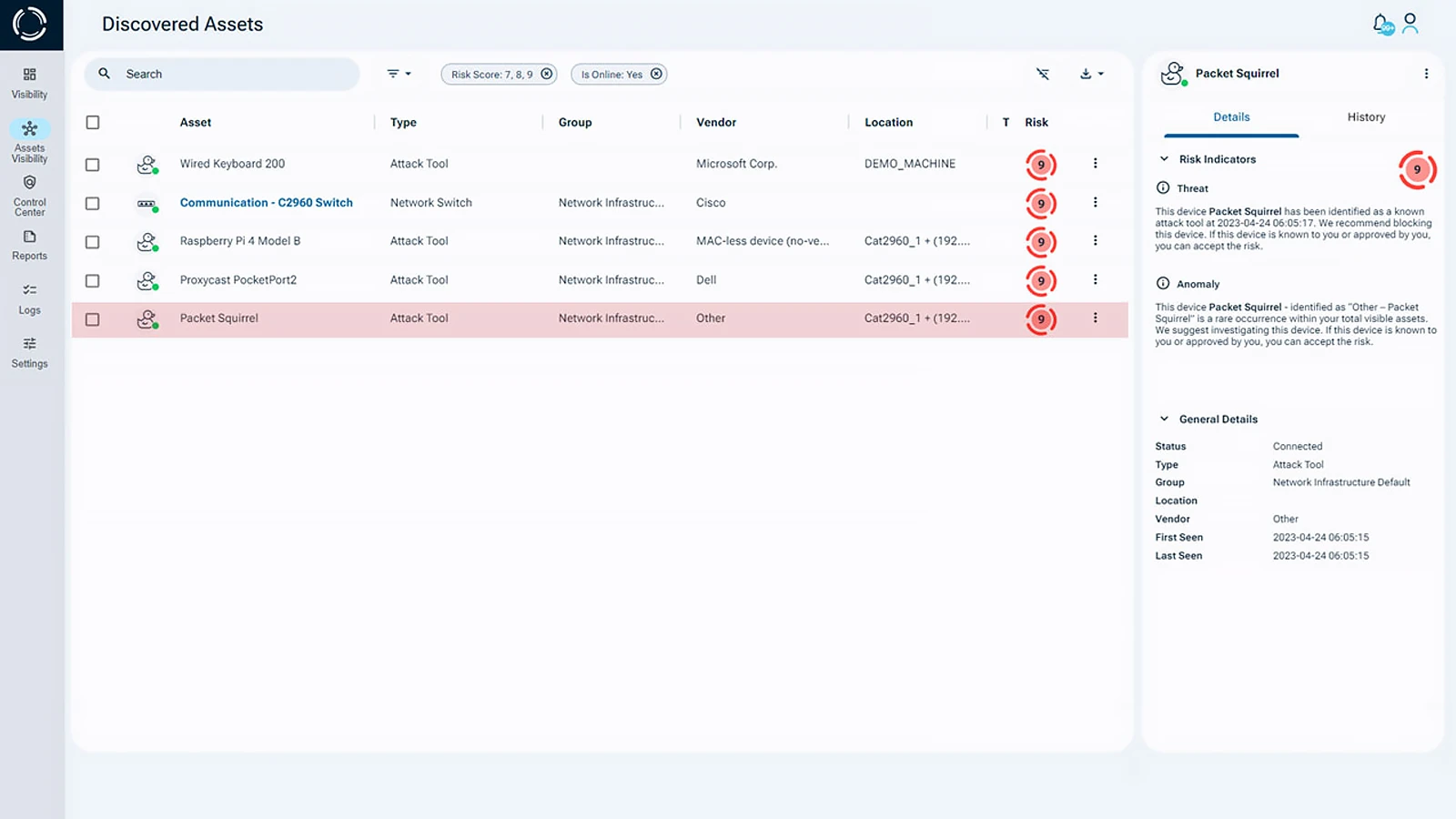What is Hardware Security?
Hardware security refers to the protection of physical devices and their components from a range of threats, including unauthorized access, tampering, theft, and cyberattacks. It involves implementing hardware cyber security measures to ensure the integrity, confidentiality, and availability of both the device and the data it processes.
Hardware security is addressed at the physical layer by Sepio’s Asset Risk Management (ARM), which provides complete visibility into all connected assets on enterprise networks. ARM enables hardware-based risk management and strengthens the security of hardware assets by detecting and mitigating threats posed by malicious devices, whether connected via USB or network interfaces. With easily adjustable policies or default settings, you can block USB ports and disable any risky asset in real-time as soon as it is connected. ARM can be implemented progressively, starting with inventory visibility, followed by risk visibility, and culminating in the enforcement of specific security policies.
Hardware Security vs Network and Endpoint Security
Hardware security, network security, and endpoint security are all essential components of a comprehensive cybersecurity strategy, but they focus on different aspects of protection.
While network security focuses on protecting data and communication channels across the network, and endpoint security aims to secure individual devices (such as computers and smartphones) from cyber threats, hardware security specifically targets the physical components that make up the network infrastructure, such as servers, routers, and IoT devices.
Hardware Security and Rogue Devices
Hardware security is often overlooked compared to software security. However, it’s crucial for protecting physical components from cyberattacks. Hardware attack devices, commonly known as rogue devices, often go undetected by traditional cybersecurity software tools. This false sense of security leaves enterprises vulnerable to hardware-based attacks and potential data breaches. Incorporating robust hardware cybersecurity solutions into enterprise networks is essential for preventing rogue device attacks at the physical layer.
In this blog, we will explore various cybersecurity hardware risks that enterprise networks face, including supply chain attacks, hardware implants, and unauthorized peripheral devices. We will also explain how Sepio’s platform enhances network security by detecting and mitigating these risks through comprehensive monitoring and analysis of all hardware assets at the physical layer.
Validating the Security of a Hardware Device
Unlike traditional cyber security tools that focus on scanning peripheral connections, Sepio goes further by looking at the intrinsic Hardware Bill of Material (HBOM) components. This involves identifying the physical profile of each hardware device during its connection at the physical layer. This capability allows Sepio to discover and profile all connected peripheral devices. It also allows for the identification and detection of potentially malicious USB devices, even those embedded within legitimate USB devices. Securing your network also requires vigilant oversight of computer security, ensuring they are protected from tampering and unauthorized access.
Hardware security is at the core of Sepio’s Asset DNA technology, which operates at the physical layer and focuses on device existence rather than behavior. This approach effectively detects all managed, unmanaged, and hidden devices. By leveraging innovative methods and machine learning algorithms, Sepio identifies the true source of asset risk, eliminating misconceptions caused by false profiles and behavioral assumptions.
Sepio’s platform ranks assets according to their risk levels and implements precise hardware cybersecurity access controls. It automatically blocks devices that violate established rules or are recognized as known attack tools.
Hardware Security and Assets Inventory
Hardware security requires maintaining a comprehensive inventory of all hardware-connected devices on a network. Sepio’s platform provides unique visibility into all connected hardware devices, enabling the discovery and identification of managed, unmanaged, or concealed devices. This asset risk management visibility is essential for evaluating and addressing network security vulnerabilities.
Sepio’s platform stands out in the field of network cyber security by leading a comprehensive audit for an organization’s entire hardware ecosystem. A hardware risk indicator is used to assess actions or activities that could harm organizational assets. The Sepio platform provides enterprises with a risk score ranging from 1 to 9, where 9 represents a high security risk and 1 indicates a low-risk posture. Each hardware risk indicator also receives an individual score, offering a granular breakdown of the assessment.

Hardware Cyber Security Risk Awareness
Phishing schemes often manipulate employees into actions that compromise security, such as plugging in malicious USB drives or clicking links that deploy malware. Investing in security training helps employees identify and defend against these threats, protecting hardware assets from compromise.
While enterprises strengthen defenses against traditional cyberattacks, hardware security often remains overlooked, leaving it vulnerable to covert hardware attacks. Rogue devices, like USB HID-emulating tools or physical layer network implants, can bypass detection by existing solutions, including Network Access Control (NAC), Intrusion Detection Systems (IDS), and IoT network security tools.
Sepio brings visibility and clarity to network-connected hardware, enhancing hardware cybersecurity risk awareness. The absence of effective hardware-focused security solutions often results in unnoticed vulnerabilities and a false sense of security. Sepio’s platform highlights the importance of hardware security across enterprise networks, ensuring risks from connected assets are properly addressed.
Hardware security is critical in protecting your network from hardware-based attacks that can compromise its integrity. Learn more about these attacks and how they threaten your hardware security. For further insights, explore our comprehensive guide on hardware cybersecurity.
Prioritize and Mitigate Hardware Asset Risks
Having comprehensive visibility into all network assets is a crucial prerequisite for effective hardware defense. However, the value of this knowledge lies in its practical application. Sepio’s ARM enables you to promptly discern which network devices require attention. Leveraging Asset DNA technology and policy rules, it provides alerts for high, medium, and low risks, expediting time to resolution, identifying regulatory gaps, and foiling hardware attack tools.
The real-time actionable visibility offered by Sepio enables your security experts to gain a deeper understanding of your device attack surface and proactively manage hardware defense. Preventing social-engineering attacks and denial-of-service attempts is a key aspect of securing enterprise infrastructure.
Improve Your Hardware Cyber Security
Gain a comprehensive understanding of your enterprise’s hardware cyber security posture with Sepio assessment. Uncover weaknesses, make informed adjustments, and improve your overall security posture. Explore the power of Sepio and the valuable risk insights it provides for improved network hardware security.
Talk to an expert. It will help you understand how to use Sepio’s patented technology to gain control of your asset risks.




